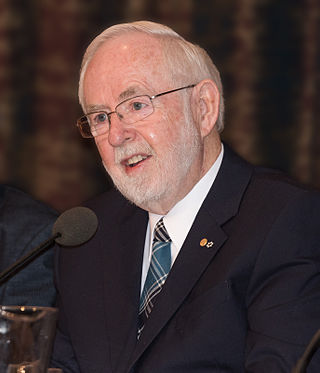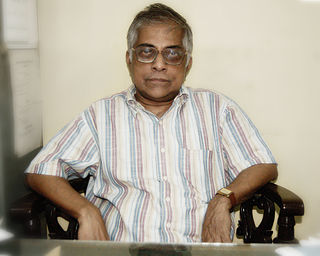Related Research Articles

John Norris Bahcall was an American astrophysicist and the Richard Black Professor for Astrophysics at the Institute for Advanced Study. He was known for a wide range of contributions to solar, galactic and extragalactic astrophysics, including the solar neutrino problem, the development of the Hubble Space Telescope and for his leadership and development of the Institute for Advanced Study in Princeton.

Arthur Bruce McDonald, P.Eng is a Canadian astrophysicist. McDonald is the director of the Sudbury Neutrino Observatory Collaboration and held the Gordon and Patricia Gray Chair in Particle Astrophysics at Queen's University in Kingston, Ontario from 2006 to 2013. He was awarded the 2015 Nobel Prize in Physics jointly with Japanese physicist Takaaki Kajita.

Bikash Sinha was an Indian physicist who was active in the fields of nuclear physics and high energy physics. Sinha was the director of the Saha Institute of Nuclear Physics and Variable Energy Cyclotron Centre and the chairman of the Board of Governors of the National Institute of Technology, Durgapur in June 2005. He was also a member of scientific advisory board to the Prime Minister of India.

Amitava Raychaudhuri is an Indian theoretical particle physicist. He is Professor Emeritus at the Physics Department of the Science College, University of Calcutta where he earlier held the Sir Tarak Nath Palit Chair Professorship. He is the nephew of another renowned Indian physicist, Amal Kumar Raychaudhuri.
Amol Dighe is a Professor of Physics in Tata Institute of Fundamental Research, Mumbai, India. He studied in Saraswati Secondary School, Thane, Maharashtra up to 10th grade and attended D. G. Ruparel College for the next 2 years. He was awarded the Shanti Swarup Bhatnagar Prize for science and technology, the highest science award in India, for the year 2013 in physical science category. His main research interest is in the area of high energy physics with focus on particles known as neutrinos, their nature and the role they play in astrophysics and cosmology. Dighe completed his BTech in Engineering Physics (1992) from Indian Institute of Technology, Bombay, MS and PhD (1997) from University of Chicago. Later he did postdoctoral research at ICTP, Trieste, CERN and Max Planck Institute before joining TIFR as a faculty member in 2003. He is a fellow the Indian Academy of Sciences and has won the Swarnajayanti Fellowship from the Department of Science and Technology, Government of India.

Rohini Godbole is an Indian physicist and academic specializing in elementary particle physics: field theory and phenomenology. She is currently a professor at the Centre for High Energy Physics, Indian Institute of Science, Bangalore. She has worked extensively on different aspects of particle phenomenology over the past three decades, in particular on exploring different aspects of the Standard Model of Particle Physics (SM) and the physics beyond it (BSM). Her work regarding hadronic structure of high-energy photons outlined a variety of ways in which to study it and has had implications for the design of next generation electron positron colliders. She is an elected fellow of all the three academies of Science of India and also the Science Academy of the Developing World (TWAS).
Shashikumar Madhusudan Chitre FNA, FASc, FNASc, FRAS was an Indian mathematician and astrophysicist, known for his research in Astronomy and Astrophysics. The Government of India honored him, in 2012, with Padma Bhushan, the third highest civilian award, for his services to the sciences.
Ramanath Cowsik is an Indian astrophysicist and the James S. McDonnell Professor of Space Sciences at Washington University in St. Louis. He is considered by many as the father of astroparticle physics. A recipient of the Shanti Swarup Bhatnagar Prize, Cowsik was honored by the Government of India, in 2002, with the fourth highest Indian civilian award of Padma Shri
Badanaval Venkatasubba Sreekantan was an Indian high-energy astrophysicist and a former associate of Homi J. Bhabha at the Tata Institute of Fundamental Research (TIFR). He was also a Dr. S. Radhakrishnan Visiting Professor at the National Institute of Advanced Studies, Bangalore.

Takaaki Kajita is a Japanese physicist, known for neutrino experiments at the Kamioka Observatory – Kamiokande and its successor, Super-Kamiokande. In 2015, he was awarded the Nobel Prize in Physics jointly with Canadian physicist Arthur B. McDonald. On 1 October 2020, he became the president of the Science Council of Japan.
Wang Yifang is a Chinese particle and accelerator physicist. He is director of the Institute of High Energy Physics (IHEP) of the Chinese Academy of Sciences in Beijing and known for contributions to neutrino physics, in particular his leading role at Daya Bay Reactor Neutrino Experiment to determine the last unknown neutrino mixing angle θ 13.

Kasturi Lal Chopra was an Indian materials physicist and a former director of the Indian Institute of Technology, Kharagpur. He was the founder of the Thin Film Laboratory at Indian Institute of Technology, Delhi and the Microscience Laboratory at IIT, Kharagpur and held several US and Indian patents for his research findings. Author of a number of books on thin film technology, he was a recipient of Shanti Swarup Bhatnagar Prize, the highest Indian award in the science and technology categories. The Government of India awarded him the fourth highest civilian honour of the Padma Shri, in 2008, for his contributions to science and engineering.

Jitendranath Goswami is an Indian scientist from Jorhat, Assam. He was the Chief Scientist of Chandrayaan-1, and was also the developer of this project. He served as a director of Physical Research Laboratory situated at Ahmadabad, Gujarat. He was also associated with Chandrayaan-2 and Mangalyaan.

Bhupendra Nath Goswami is an Indian meteorologist, climatologist, a former director of the Indian Institute of Tropical Meteorology (IITM). and a Pisharoty Chair Professor at the Indian Institute of Science Education and Research. He is known for his researches on the Indian monsoon dynamics and is an elected fellow of all the three major Indian science academies viz. Indian National Science Academy, Indian Academy of Sciences, and the National Academy of Sciences, India as well as The World Academy of Sciences. The Council of Scientific and Industrial Research, the apex agency of the Government of India for scientific research, awarded him the Shanti Swarup Bhatnagar Prize for Science and Technology, one of the highest Indian science awards for his contributions to Earth, Atmosphere, Ocean and Planetary Sciences in 1995.
Virendra Singh is an Indian theoretical physicist and a former C. V. Raman chair professor and director of the Tata Institute of Fundamental Research (TIFR). Known for his research in high energy physics, Singh is an elected fellow of all the three major Indian science academies - Indian National Science Academy, Indian Academy of Sciences and National Academy of Sciences, India as well as The World Academy of Sciences. The Council of Scientific and Industrial Research, the apex agency of the Government of India for scientific research, awarded him the Shanti Swarup Bhatnagar Prize for Science and Technology, one of the highest Indian science awards, for his contributions to Physical Sciences in 1973.
Sudhanshu Shekhar Jha is an Indian condensed matter physicist and a former director of Tata Institute of Fundamental Research. Known for his research in optoelectronics, Jha is an elected fellow of all the three major Indian science academies – Indian National Science Academy, National Academy of Sciences, India and Indian Academy of Sciences – as well as of The World Academy of Sciences and American Physical Society. The Council of Scientific and Industrial Research, the apex agency of the Government of India for scientific research, awarded Jha the Shanti Swarup Bhatnagar Prize for Science and Technology, one of the highest Indian science awards, for his contributions to Physical Sciences in 1979.
Probir Roy is an Indian particle physicist and a former professor at Tata Institute of Fundamental Research. He is also a senior scientist of the Indian National Science Academy at Bose Institute and a former Raja Ramanna fellow of Department of Atomic Energy at Saha Institute of Nuclear Physics.
Biswarup Mukhopadhyaya is an Indian theoretical high energy physicist and a senior professor at Indian Institute of Science Education and Research, Kolkata. Known for his research on High energy colliders, Higgs bosons, neutrinos, Mukhopadhyaya is an elected fellow of the National Academy of Sciences, India. The Council of Scientific and Industrial Research, the apex agency of the Government of India for scientific research, awarded him the Shanti Swarup Bhatnagar Prize for Science and Technology, one of the highest Indian science awards, for his contributions to physical sciences in 2003.
Sumathi Rao is an Indian theoretical physicist and professor at the International Centre for Theoretical Sciences, Bengaluru, working in the field of condensed matter physics. She is a former member of women in physics promotion of International Union of Pure and Applied Physics (IUPAP) from 2000 to 2008.

Bonnie T. Fleming is an experimental particle physicist who has held leadership roles in several physics experiments and at Fermilab. Since 2022, she has been Fermilab's chief research officer and deputy director for science and technology. She has also served on the faculty of Yale University and the University of Chicago. Fleming is an expert in neutrino physics and liquid argon time projection chamber detector technology.
References
- ↑ "Fellow Profile Srubabati Goswami". Indian Academy of Sciences . Retrieved 31 August 2019.
- ↑ "A Trailblazer Looks for the Keys to the Next Generation of Physics Research". Aashima Dogra. The Wire. 7 September 2017. Retrieved 31 August 2019.
- ↑ "Srubabati Goswami". Indian Academy of Sciences . Retrieved 31 August 2019.
- ↑ "Professor Srubabati Goswami". Indian National Science Academy . Retrieved 31 August 2019.
- ↑ "Fellows". National Academy of Sciences, India . Retrieved 31 August 2019.
- ↑ "A tale of two lives" (PDF). Indian Academy of Sciences . Retrieved 31 August 2019.